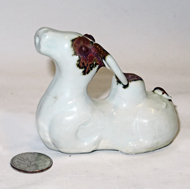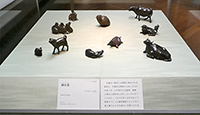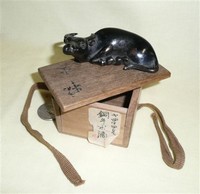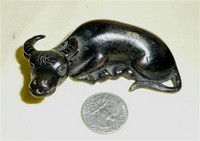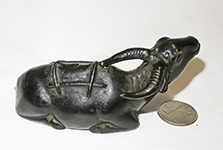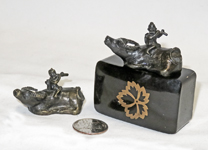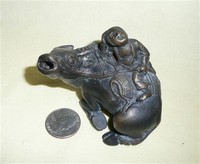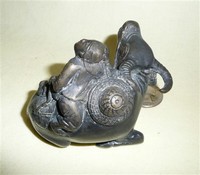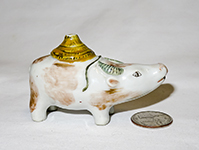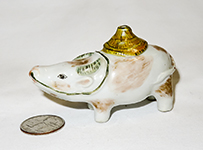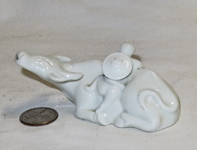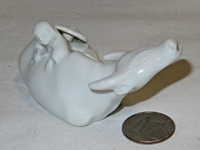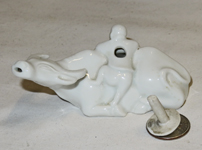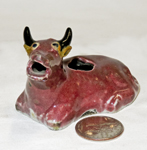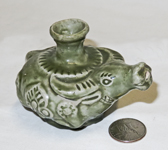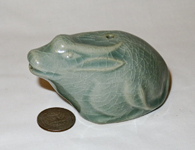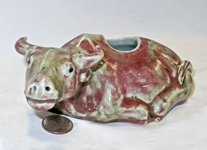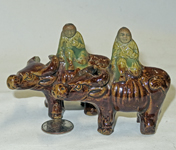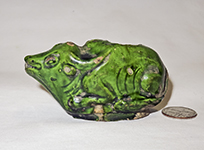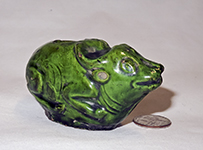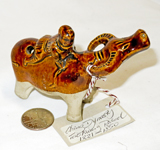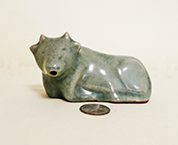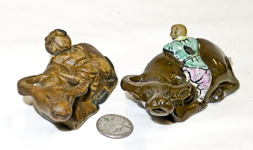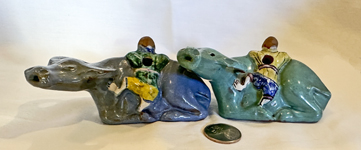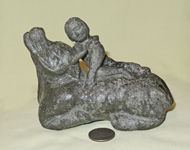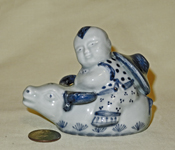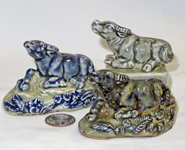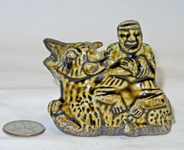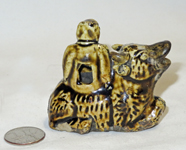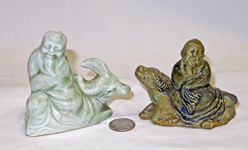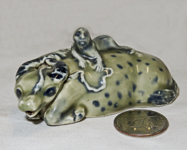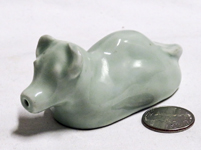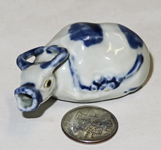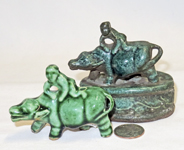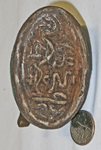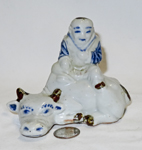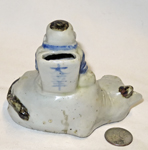
Suiteki
As I stated on the home page, this is a later addition to the collection, of interest to me because they meet the ‘two hole’ rule, and because I wanted some traditional versions of a cow, bull, ox or water buffalo from the lactose intolerant populations of the Far East... and also, as noted below, because my wife got me hooked on them.
Probably the best overall explanation of suiteki that I have found comes from a very informative article at the Japanese Art and Architecture Net Users System (JAANUS) web site, from which -- and I quote – we learn that the Japanese term Suiteki means:
| Lit. water-dropper. A small container used to hold the water which is added to the inkstone ‘suzuri’ during the grinding of the ink stick. Water-droppers may be made of copper, jade and stone, but ceramic are the most popular. Depending on their size and shape, water-droppers may also be termed suichuu, suichuujou (also suijou), suiu or senjo. More specifically, a suiteki has two small holes for water and air and is designed so that only a few drops of water can fall at one time. Suichuu are shaped like pitchers and have a pouring spout and a handle. Suiu and suijou are bowl or jar-like, and some have wide mouths, making them popular for use as brush washers (hissen), while others have small mouths. Senjo, or "toad", was so named because a toad was believed to hold water in its large belly. Thus many jade toad-shaped water-droppers exist. At first the suiteki was simply a jar or bowl used for holding water, but as interest in the accoutrements of calligraphy grew, water-droppers became more specialized. Bronze water-droppers in the shapes of fantastic creatures [monsters], ceramic suiu and teapot-shaped suichuu were created in China and found their way to Japan and became popular with the literati of the Edo period. In Japan, suiteki were already used in the Nara period (7c) when sutra copying flourished. A set from this period made up of a bronze water-dropper, a spoon and a tray used to hold the ink stick are preserved at Houryuuji, Nara. Since the late Heian period (11c), a special kind of writing box ‘suzuribako’, which includes the water-dropper, in addition to the ink stone and other writing tools, became very popular. The water-droppers varied greatly in material, shape and design. Notable, are the elaborately designed ceramic suiteki, including many animal-shaped examples, that were found among old Seto (13c) and Oribe (16c) wares (see ‘setoyaki’, ‘oribeyaki’) Water-droppers of richly colored cloisonne (shippou) also became popular from the 16c. |
|
I have my wife (a calligrapher among her other talents) to thank, or perhaps to blame, for this extension of the collection, since she bought me this lovely porcelain water dropper (it’s missing a horn) in a Hong Kong antique shop while I was busy on business. It was the only one I had, with no intention of acquiring more, until we visited Japan a couple years later and… |
|
|
We noticed three cows among this 19c Edo period bronze water dropper collection in the Tokyo National Museum. Naturally enough, since for some reason the museum didn’t want to part with them, I started hitting the web to learn more about them. There’s also a (pricey) book entitled “Suiteki - The Art of Bronze Water Droppers” if you really want to get serious. |
|
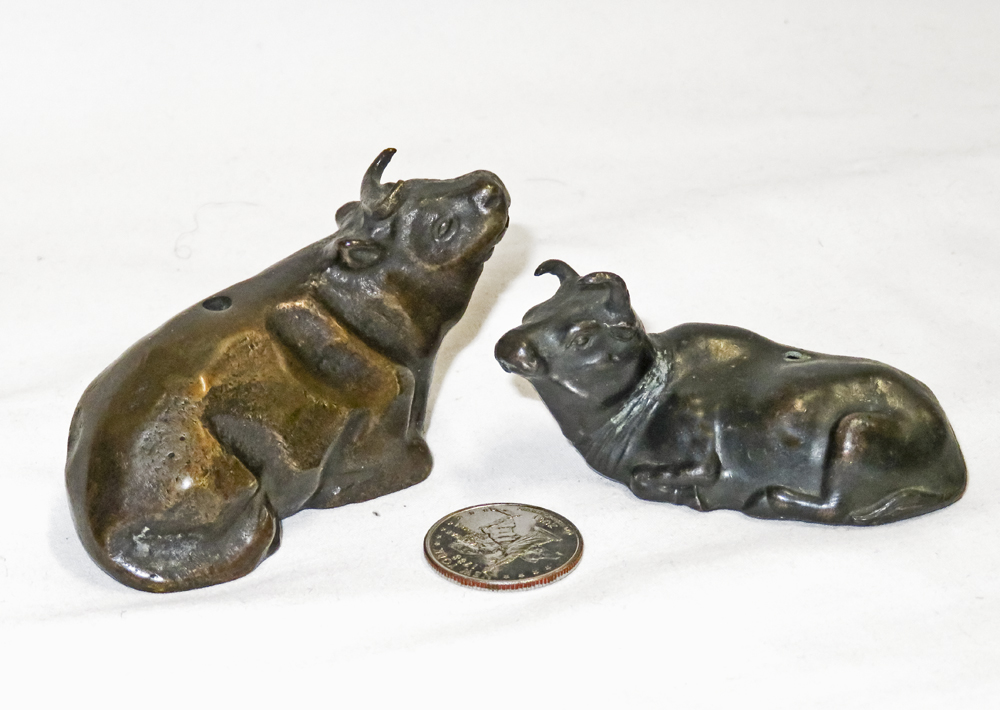 |
I may not have been able to buy the bronze cow suiteki that were in the museum, but I have managed to acquire a few lovely examples, such as these simple reclining beasts. The larger and fatter one came to me from Kumamoto, on the western shore of Kyushu. The other arrived from Okayama in southern Honshu. Many of my other Japanese suiteki feature what would seem to be working bulls or water buffalo, but these are pretty clearly cows for milking or more likely for eating. The fatter one looks like it would be great for the world renowned Kobe Beef. Both are beautifully molded and cast, and the smaller one even has the leg beneath depicted. |
|
|
|
|
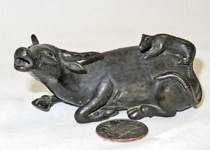 |
Here is a well-crafted but rather unusual bronze Japanese suiteki. The bull appears to be in considerable pain with its eyes wide, right foreleg raised, and a small animal clinging to its rump. I can’t figure out what that animal is – but presumably it has claws and is more interested in meat than companionship. There may well be a story or ‘fairy tale’ that goes with it, but the Japanese seller provided no information. |
 |
This heavy (480g) bronze reclining cow suiteki was made in two pieces, with the closely fitting base welded or glued into the top. the small drop hole is on the tip of its nose between the nostrils. The cow has a bump on its forehead which is either a beetle or, more likely, a small simple Buddha figure. There is a large bizen suiteki further down the page that also has a Buddha on its forehead so I'm pretty sure that's what it was meant to be. The seller, from Hyogo Japan, said it was post-1940 although it looks to me to have a bit of age. But then I was born in 1940 and I too have a bit of age... |
|
This small but very well done early 20c copper or bronze suiteki of a boy with a flute riding a water buffalo came to me from Okayama, Japan, which is about half-way between Kobe and Hiroshima. The seller told me that the boy or man riding a water buffalo is a traditional theme of Zen Buddhism – which of course sent me to digging through the web. I learned that this is a representation of the sixth stage from an early Taoist story of the ‘Ten Bulls’ that (according to Wikipedia) may represent a Zen Buddhist interpretation of the ten stages experienced by a Bodhisattva as outlined in various Mahāyāna sūtras. The wikipedia article states that the story as related by the 12c Chinese Zen master Kuòān Shīyuǎn has pictures, poems and short pieces of prose that “tell how the student ventures into the wilderness in his search for "the Bull" (or "Ox"; a common metaphor for enlightenment, or the true self, or simply a regular human being), and how his efforts prove fruitless at first. Undeterred, he keeps searching and eventually finds footprints on a riverbank. When he sees the bull for the first time he is amazed by the splendour of its features ('empty and marvelous' is a well known phrase used to describe the perception of Buddha nature). However, the student has not tamed the bull, and must work hard to bring it under control. Eventually he reaches the highest Enlightenment, returns to the world and ‘everyone I look upoon becomes enlightened’.” The sixth stage has the man riding the bull home in great joy, and in the 12c picture he is playing a flute. Whether or not this is the correct interpretation of this suiteki, many in my collection – Chinese as well as Japanese – feature a person riding, climbing or lying on a standing or reclining bull (water buffalo). |
|
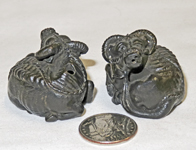 |
Here is a nice pair of reclining bronze Japanese water buffalo – great detail, down to the rope through the nose. One of these came to me from California a couple years ago – then I couldn’t resist its twin, which arrived direct from a seller in Tottori-shi, Tottori-ken, Japan. That of course sent me to the web, where I learned that Tottori Prefecture, located in the Chugoku region of southwest Honshu, is the least populous prefecture in Japan, and has the nation’s only large area of sand dunes. From Wikipedia, always the source of fun information, I found that ‘The word "Tottori" in Japanese is formed from two kanji characters. The first, 鳥, means "bird" and the second, 取 means "to get". Early residents in the area made their living catching the region's plentiful waterfowl. The name first appears in the Nihon shoki in the 23rd year of the Emperor Suiko when Yukuha Tana, an elder from the Izumo, visits the emperor. The imperial Prince Homatsu-wake was unable to speak, despite being 30 years of age: "Yukuha Tana presented the swan to the emperor. Homatsu-wake no Mikoto played with this swan and at last learned to speak. Therefore, Yukaha Tana was liberally rewarded, and was granted the title of Tottori no Miyakko." |
|
This very heavy bronze, well made suiteki with a mythical beast in a medallion on each side and a very lerge ornate handle is said to be Meiji (1868-1912) from the late Edo period, and has a 3-character maker’s mark on the bottom. It came from the collection of Masayuki Sashide of Yokohama, who was a well known collector as well as dealer. It was acquired by another knowledgeable collector/dealer who became closely acquainted with Sashide while he lived in Yokohama in 2009-2010. He called it a robust water buffalo, and given the provenance I think that’s what it is intended to represent. |
|
|
|
This boy on his ox or water buffalo is also Seto-ware, from the Meiji (1868-1912) period. He is colorfully dressed and has a top-knot. Apparently the potter had a bit of a sense of humnor because the finger hole used to control the water flow is located directly in the midle of the boy's butt. I got it at a rock-bottom price (in spite of my bid on esnipe) because for some reason not one else bid on it and the knowledgavble Japanese seller rom Tottori-shi starded the bidding low. |
|
|
|
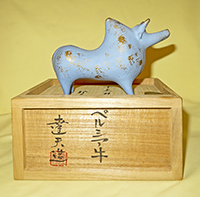 |
This is another very idiosyncratic but modern Japanese suiteki. Its shape reminds me very much of an ancient Amlash culture bull rhyton (there is a version of one on my Rhytons page), but whether that – or a bad dream – was the inspiration I really don’t know. It came in a beautiful wooden box that contained a paper telling a bit about the ceramicist, Tatsuo Amano. The seller gave me a partial translation, stating that he was “Born in Showa 7 (1932) in Kyoto, Learned pottery skills under Gorosuke Asami, Kunio Uchida, Kaizan Shinkai and Rokubei Zhimizu VI., Established his own kiln in Showa 30 (1955) in Senryuji, Kyoto city and mainly produced flower vases. He is a member of the Japan Fine Arts Exhibition, Nihon sinkougei and so on.” |
|
This very fine Japanese example, a small resting porcelain Bull, is from the early Showa period, ca 1930. I acquired it from a Honolulu antique store. |
|
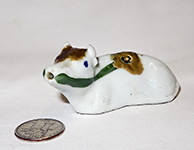 |
This very cute small blue-eyed ceramic Japanese suiteki came to me from Nagasaki. The seller said (in 2019) that he thought it was about 40 years old. |
 |
This rather large suiteki cow with the long bushy tail has a little Buddha-like figure on its forehead. The seller said it was 50-100 years old. It is bizen-ware, an iron-hard, wood fired unglazed type of pottery. Wikipedia notes that “Bizen is named after the village of Imbe in Okayama prefecture, formerly Bizen Province (on the southern coast of western Honshu). This artwork is Japan's oldest pottery making technique, introduced in the Heian period. Bizen is one of the six remaining kilns of medieval Japan.” |
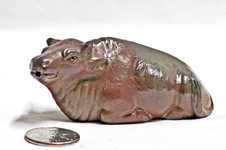
Here is a second bizen ware or, as the Japanese seller called it, bizen-yaki suiteki, this time in the form of a seemingly well fed and contented reclining cow. The seller states that it dates from the Japanese Meiji period, 1868-1912, and notes that bizen does not have glaze applied, rather that a sort of natural glaze develops in the kiln. He also says, "sometimes we represent it with a Wabi-Sabi". I dashed to Wikipedia for help with that, and discovered that "In traditional Japanese aesthetics, wabi-sabi (侘寂) is a world view centered on the acceptance of transience and imperfection. The aesthetic is sometimes described as one of beauty that is "imperfect, impermanent, and incomplete". It is a concept derived from the Buddhist teaching of the three marks of existence (三法印 sanbōin), specifically impermanence (無常 mujō), suffering (苦 ku) and emptiness or absence of self-nature (空 kū).Characteristics of the wabi-sabi aesthetic include asymmetry, roughness, simplicity, economy, austerity, modesty, intimacy, and appreciation of the ingenuous integrity of natural objects and processes....According to Leonard Koren, wabi-sabi can be defined as 'the most conspicuous and characteristic feature of traditional Japanese beauty and it occupies roughly the same position in the Japanese pantheon of aesthetic values as do the Greek ideals of beauty and perfection in the far West.' Whereas Andrew Juniper notes that 'If an object or expression can bring about, within us, a sense of serene melancholy and a spiritual longing, then that object could be said to be wabi-sabi.' For Richard Powell, 'Wabi-sabi nurtures all that is authentic by acknowledging three simple realities: nothing lasts, nothing is finished, and nothing is perfect.'" This lovely piece does have a tiny chip on the tip of the left horn, but given the above definitions, that seems totally appropriate. |
|
This very cute little bull or cow of white clay with heavy black glaze is Kyoto ware, also known as Kiyomizu-yaki . It dates from ~1985 and was made by and marked for Kenji Suzuki (1935-2010), a renowned Kyoto artist who is succeeded by his sons Kenji II and Takuji. One blog on the web states that he said he used glazes from the ash of an orange tree or bamboo near his home. |
|
|
This interesting Japanese celadon suiteki of unknown date – but not new - came from Kobe. |
|
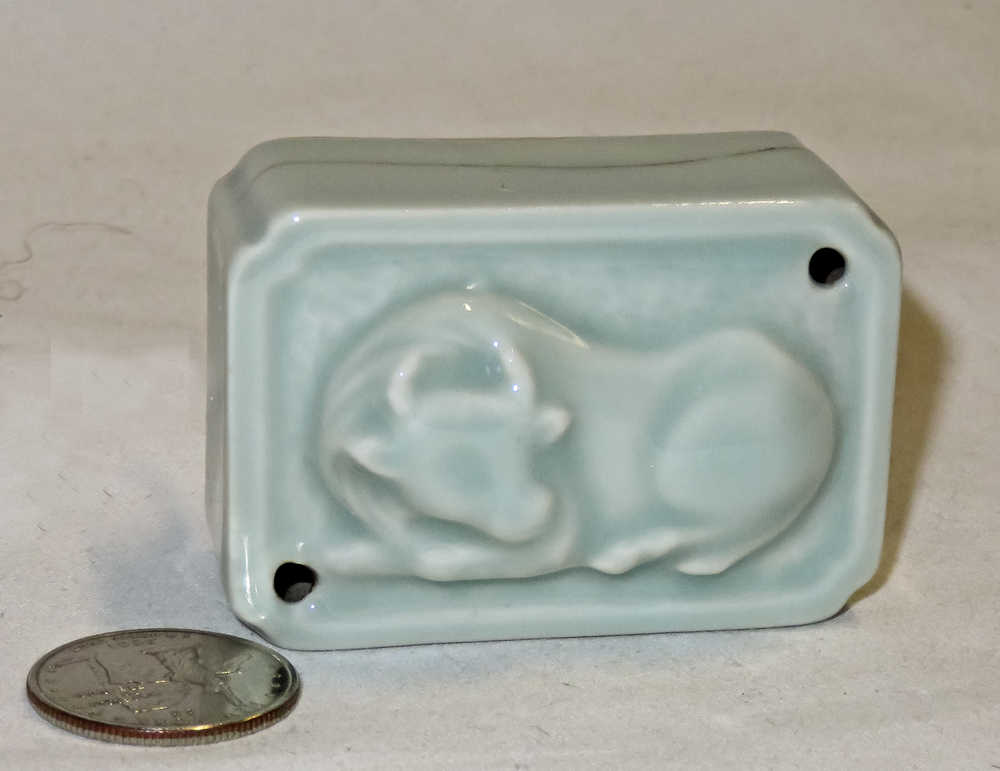 |
This simple but lovely rectangular water dropper with a raised sleeping cow is also presumably Japanese. I have seen it offered in dark brown as well. |
|
This is an interesting heavy suiteki of a boy on a water buffalo, possibly Korean. It has lost its left horn. |
|
|
Here is a very simple but nice squatting bull, with his long ears and horns laid back agaib mst the body. He is celadon, Korean, and nicely crackled. . |
|
|
Moving now to Chinese calligraphy instruments, let's start with one that's not a water dropper but rather a lovely 'water pot' - with a large hole on the top and no 2nd or pouring hole - used for washing brushes. This is another exception to my rule, but it's very well made and accompanies the water droppers and other 'scholar's' implements for writing and painting. Japanese versions of such water pots are often referred to (on ebay at least) as suiteki suichi, but I have no idea what term the Chinese use. This water buffalo or bull is particularly beautiful as well as quite large (7” long). It is glazed in what the seller termed ‘sang de boeuf’. From Carters.com we learn that “Flambé glazes, termed ‘sang-de-boeuf’ (ox blood) were in use by the Chinese from the 11th century, and the effect was achieved by using copper oxide as a colouring agent and firing the object in a reducing atmosphere. In the 18th century the red glaze often accumulated on the shoulders of vases and bowls, reproducing the effect of coagulated blood. Sometimes the glaze was often slightly streaked, or included blue bleeds and wares with these features were prized by collectors in the 19th century. European potters were not able to master the technique until the early 20th century.” The glaze on this pot seems to me to be somewhat too light for that, and is mottled with a grey-green background and dark green occasional spots. Perhaps some expert can enlighten me. Like other of my vintage Chinese pieces the bottom is rough and unglazed. It came to me from northern Wales, but the seller said she bought it at an antique center in Singapore around the turn of the millennium. |
|
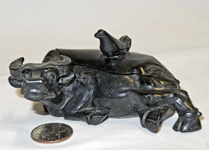 |
Here is a second Chinese water pot, a black stone reclining water buffalo with a lid with a bird on top. It's modern, post 1940 according to the seller's description. |
|
This pair of early earthenware Chinese water droppers picture what the seller said were ‘immortals’ riding water buffalo or bulls. The bulls and the fronts of the men (but not their faces or backs) are coated with Sancai which (again turning to Wikipedia for information) translates as ‘three colors’ and “ is a type of lead-glazed pottery: lead oxide was the principal flux in the glaze, often mixed with quartz in the proportion of 3:1. The polychrome effect was obtained by using as coloring agents copper (which turns green), iron (which turns brownish yellow), and less often manganese and cobalt (which turns blue).” The seller said that this pair came from a large Chinese collection and is 17c Qing or Kangxi. The Ming Dynasty lasted from 1368-1644, and was followed by the Qing (last Imperial) dynasty which lasted until 1912. Kangxi (4 May 1654-20 December 1722), considered one of China’s greatest emperors and the longest-reigning, was the 4th Qing emperor, and ruled for 61 years, from 1661-1722. It would take an expert to verify this attribution or narrow things down a bit and I’m certainly not one, but at the very least it makes a good story and these very interesting water droppers are fully appropriate to lead off my Chinese water dropper area. |
|
|
|
| This nicely molded long-snouted water buffalo with a faceless rider that appears to be mostly lying down, has a deep caramel glaze above but is unglazed below. The seller said it came from the estate of a former marina operator who had an extensive and quite fine Chinese collection, and although he himself knew nothing about it, it had a tag reading Ching (Qing) Dynasty, Tao Kuang Period 1821-1850. | |
|
|
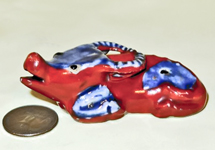 |
This is a very bright Qing Dynasty water dropper – the seller called it an antelope but it looks like a fanciful bull or water buffalo to me. It’s very pretty in any case. It comes in other colors also - all of them quite pricey. |
|
This little lying down celadon cow is also Chinese, and probably also Qing dynasty – certainly not a modern reproduction. |
|
|
here is a well fashioned simple blue cow Chinese water dropper - unmarked, but like the one above with some age and almost certainly intended for a scholar, not simply a modern reproduction. From the positions of the fill hole and head, it would appear to be most easily used in the left hand. |
|
|
|
|
|
|
|
|
|
This little fat Chinese boy seems to have sugccessfully mounted his recombent beast. This is a modern piece - and I suspect that the boy dates from the era when the Chinese were allowed to have only one child, that was often then spoiled - "little emperpors" I think they called them. Whatever, this kid has definitely had too much to eat. |
|
|
Here are three modern Chinese porcelain suiteki all featuring the same reclining ox or water buffalo – two on a rock and the third on a seal. They all hail from Bejing. |
|
Here's a very different interpretation of the bull on a rock - though why that seems to be a recurrent theme I don't understand because it certainly can't be comfortable for the bull. The seller of this one said he got it at antique market in China in the late 1990s, though it doesn't appear to be very old. |
|
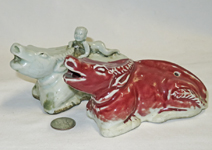 |
These are exceedingly large (for a suiteki) modern Chinese water droppers. I first acquired the red one – couldn’t resist at 99 cents plus postage – and then found the grey one with the naked boy on top for considerably more, but with postage paid from Beijing. My wife, a calligrapher, tried them both and says that the one with the boy has the filler/stopper hole in a much more convenient location for a right-handed person. |

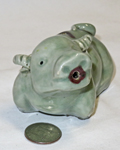
|
|
|
|
|
|
|
|
|
|
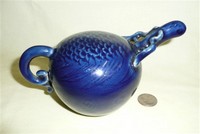 |
This rather large, stylized, modern water dropper – I’ve seen it offered in a variety of colors – may not have been intended to be a cow, but then I occasionally have a rather vivid imagination. |
 |
This one also takes a bit of imagination for it to be a cow…the seller said it was a donkey, but I’ve never seen a donkey with horns. Possibly a sheep but they don’t generally lie down like that. Thus it’s some variant of water buffalo or cow-like creature, and at the low price, close enough for me. In addition to the interesting pattern on its sides, it has a blue stamp with illegible Chinese characters on the bottom |
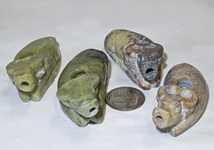 |
These four soapstone small Chinese suiteki are fairly old – said by the seller to come from a “large collection of high quality antiquities from an estate of the daughter of a former merchant sea captain stationed in Asia.” I’d guess them to be probably early 20c. |
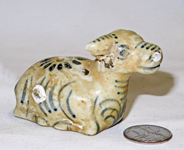

This water buffalo or bull is even older: 15c Vietnamese, recovered from the Hoi An shipwreck. It even has some marine growth to help attest to its authenticity. The seller, Ethnix Tribal and African Arts of NY (they had a really neat web site) provided the following information in the eBay description: “In the mid 15th century a junk loaded with over 250,000 fine examples of Vietnamese pottery sank to the bottom of the South China Sea in an area called the Dragons Embrace, 40km off the coast of Vietnam. The shipwreck was discovered by Vietnamese fishermen who began pulling up huge amounts of pottery in their nets. Subsequently the Vietnamese government hired a salvage company to recover the massive amount of sunken treasure which was to be auctioned later in the major auction houses, in London, Paris, New York, San Francisco, etc. As a result, the Hoi An sunken treasure has provided both financial and scholarly rewards. Sales proceeds, amounting to tens of millions of dollars, have gone to build museums in Vietnam and to pay for further excavation and research. With the discovery of previously unknown ceramic forms and design, the historical and artistic relationship between Vietnam and China has been redefined and the quality from this little known chapter of Vietnamese artistic tradition has been recognized. This piece was purchased in an antique shop in Saigon”. For more information about the shipwreck, go to http://www.thingsasian.com/ and search for Hoi An shipwreck. Really neat stories here. |
|
 |
No, not all cows…but there is a bull in this set of clay Chinese zodiac suiteki in a brocade box. Cute…couldn’t resist. |
